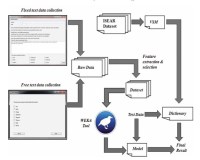The keyboard of the future will know just how you feel

Your feelings and emotions are revealed not just by what you type but how you type it. In the future, your PC could warn you if you're typing an angry memo or instant message and suggest you step away from the keyboard for a minute, and perhaps take a tea break.
Today's computers are simply tools, but tomorrow's could be "emotionally aware" systems. Researchers say: "If we could build any system that is intelligent enough to interact with humans that involves emotions, that is, it can detect user emotions and change its behaviour accordingly, then using machines could be more effective and friendly."
Nazmul Haque Nahin, Jawad Mohammad Alam, Hasan Mahmud and Kamrul Hasan from the Islamic University of Technology in Bangladesh explored the topic by measuring what users typed, and asking them to indicate their emotional state. A pop-up window gave them a choice of nine tick boxes: the standard ISEAR (International Survey on Emotion Antecedents and Reactions) emotional classes of joy, fear, anger, sadness, disgust, shame, and guilt, plus two extra ones: neutral and tired.

Hidden software collected familiar keystroke data. This included typing speed, dwell time (time elapsed between a particular key press and release), and key down-to-down time. Logs were captured when the volunteer subjects were typing out passages from Alice's Adventures in Wonderland and their own free texts.
The free texts were also evaluated using VSM (Vector Space Model) analysis to evaluate their emotional content. The research paper says: "To obtain the final result, we consider only those results as success where both keystroke dynamics and text pattern analysis shows the same result."
Their conclusion is that adding keystroke analysis to text analysis improves the accuracy of the results. See: Identifying emotion by keystroke dynamics and text pattern analysis (PDF).
One of the problems with the research was that users were much more willing to indicate positive emotions such as joy than negative ones such as anger or disgust. "So, it took more time to collect data than anticipated."
Researchers have explored other ways of measuring computer users' emotions, sometimes involving cameras (thermal imaging) and skin sensors. As noted in an earlier paper by Clayton Epp and others at the University of Saskatchewan in Canada — Identifying Emotional States using Keystroke Dynamics (PDF) — keyboard analysis has the advantages of being cheaper and less invasive, if it works.
According to New Scientist magazine, "Epp foresees an 'emotional instant messaging client': an app that works like a more sophisticated form of emoticon. Subtle cues would alert the recipient to the emotional message's tone, allowing people to communicate more naturally."
Epp's paper suggests other applications, such as in online tutoring systems, where emotions can lead to errors. Epp adds: "If a user of a safety-critical application was frustrated or distracted, it could dangerously affect their performance."
Note: There's a lot of research into "affective computing" where computers are being developed to adapt to human emotions. See Wikipedia.